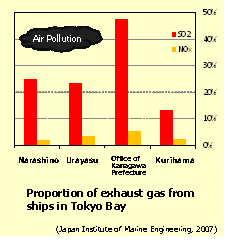- Rationale -

- Environmental Pollution
- High proportion of exhaust gas from ships in the Tokyo Bay area
- Delayed adoption of environment-improving technologies in the field of sea transport, compared to land transport and automobiles
- Preventing air and water pollution emission from conventional internal combustion engine-propelled ships -- Zero emission boats
- Creating a low carbon society
- Necessity for new shipbuilding technologies
- Reducing vibration and noise while the boat is running
- Making casting-off and mooring maneuvers easier
- Technological background -


Rapid charger
Electric Vehicle (EV) technologies developed, mass-produced and marketed
< Land-based modal shift towards low environmental stress by means of EVs >
- Development of battery technologies
- High-powered lithium battery
- Plug-in system or rapid charging system (CHAdeMO standard)
- CHAdeMO standard was set in 2007 by Tokyo Electric Power Company (TEPCO)
- 1999: The university started cooperation with TEPCO in the field of EV research
- March 2009: The university installed a rapid charger for EVs on the campus (the first university to do so)
- Dec. 2009: Car sharing test started
* The rapid charging specifications are based on those being discussed by the CHAdeMO Council, which was established in March 2010 to formulate standard specifications for the rapid charging of EVs in Japan. Specifically, the charger has a voltage of 500 V, a maximum current of 125 A (direct current) and a maximum output of 50 kW.